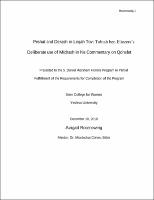Please use this identifier to cite or link to this item:
https://hdl.handle.net/20.500.12202/4503Full metadata record
| DC Field | Value | Language |
|---|---|---|
| dc.contributor.advisor | Cohen, Mordechai | en_US |
| dc.contributor.author | Rosensweig, Avigail | |
| dc.date.accessioned | 2019-07-10T16:33:01Z | |
| dc.date.available | 2019-07-10T16:33:01Z | |
| dc.date.issued | 2018-12-10 | |
| dc.identifier.citation | Rosensweig, Avigail. Peshat and Derash in Leqah Tov: Tobiah ben Eliezers’s Deliberate use of Midrash in his Commentary on Qohelet. | en_US |
| dc.identifier.uri | https://hdl.handle.net/20.500.12202/4503 | |
| dc.identifier.uri | https://ezproxy.yu.edu/login?url=https://repository.yu.edu/handle/20.500.12202/4503 | |
| dc.description | The file is restricted for YU community access only. | en_US |
| dc.description.abstract | Leqah Tov’s commentary on Qohelet demonstrates a two-layered commentary which favors midrash without neglecting peshuto shel miqra, justified specifically by the complex, contradictory, often cryptic nature of the book itself. Leqah Tov relies on midrash and midrash-style interpretation to reconcile contradictions in the text, make meaning out of nihilistic statements, and tease out religious messages he is certain are extant within the text, merely hidden. Leqah Tov is certainly not primarily a pashtan; he views the straightforward sense of Qohelet as often a surface layer which ether builds up to or even conceals the true meaning of the text. This is especially true as he sees Qohelet as fundamentally a religious text which teaches religious values. His frequent use of multiple interpretations separated by s”a transitions demonstrates that Leqah Tov did not aim towards providing a single correct interpretation of the text. However, Leqah Tov demonstrates peshat sensibilities as well. His interpretation displays a concern for matters of grammar, language, and structure. Moreover, Leqah Tov is self-aware in his use of midrash. Within his commentary there is peshat in service of midrash and midrash in service of peshat; there are some midrashim perhaps chosen based on peshat considerations, and some peshat provided in order to provide the groundwork for midrash. In this way there is a peaceful coexistence and even a symbiosis between peshat and midrash in Leqah Tov’s works. Peshat is perhaps rejected specifically in the cases where it is philosophically problematic, such as when it contradicted itself or endorses behavior which appears impious, but at other times is considered a valid layer of interpretation. Moreover, Leqah Tov’s use of midrash is neither haphazard or uncritical in nature, but is employed with a clear set of interpretational goals to elucidate the text of Qohelet. (From Conclusion) | en_US |
| dc.description.sponsorship | S. Daniel Abraham Honors Program of Stern College for Women | en_US |
| dc.language.iso | en_US | en_US |
| dc.publisher | Stern College for Women Yeshiva University. | en_US |
| dc.rights | Attribution-NonCommercial-NoDerivs 3.0 United States | * |
| dc.rights.uri | http://creativecommons.org/licenses/by-nc-nd/3.0/us/ | * |
| dc.subject | senior honors thesis | en_US |
| dc.subject | Peshat and Derash | en_US |
| dc.subject | Leqah Tov | en_US |
| dc.subject | Tobiah ben Eliezer | en_US |
| dc.subject | Midrash | en_US |
| dc.subject | Qohelet | en_US |
| dc.subject | Ecclesiastes | en_US |
| dc.title | Peshat and Derash in Leqah Tov: Tobiah ben Eliezers’s Deliberate use of Midrash in his Commentary on Qohelet. | en_US |
| dc.type | Thesis | en_US |
| Appears in Collections: | S. Daniel Abraham Honors Student Theses | |
Files in This Item:
| File | Description | Size | Format | |
|---|---|---|---|---|
| Senior Thesis Submission_Avigail Rosenswig.pdf Restricted Access | The file is restricted for YU community access only. | 1.29 MB | Adobe PDF |  View/Open |
This item is licensed under a Creative Commons License

